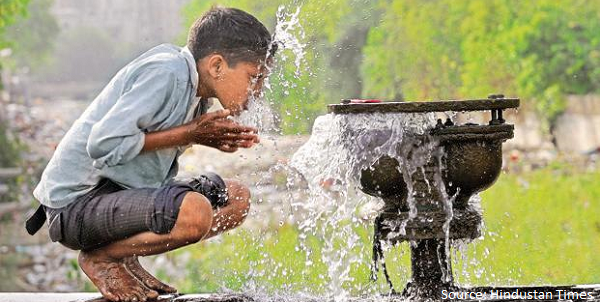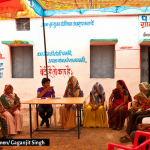
India’s thirst: How can water supply be made sustainable?
25 November 2019
Growing water scarcity is being recognised as an important problem facing India. The recent statistics in this regard are mind-boggling. By 2030, the government expects demand for water to be twice the level of supply. Demand outstripping supply could equate to a loss of 6% in India’s GDP over the course of the time period [1]. It appears that we are on the verge of an acute water crisis.
The sectors that contribute most to the economy are also excessively water dependent. For example, irrigation consumes 90% of India’s water supply. Currently, the total utilisable water resource of the country is 1,123 billion cubic metres (BCM), which includes 690 BCM of surface water and 433 BCM of ground water [2]. The demand situation is useful to note here. While the increase in population continues to put pressure on per capita water availability, a depleting water table makes the situation critical. The annual extraction of groundwater in India is over 250 BCM which is one of the highest in the world [2].
Moreover, issues like saline water intrusion in coastal areas and deteriorating water quality further curtail the availability of potable water. While 81 per cent of rural habitations are currently estimated to have access to 40 litres of water per capita per day, the coverage is only 47 per cent when estimated with 55 litres of water per capita per day. Just about 18 per cent of rural households in India have connections to piped water supply [3], which the government hopes to remedy by reaching all rural households by 2024. It is thus a huge challenge on an already resource-limited country to meet the various water needs of the people, especially of those who already lack access to clean water.
How has the government responded?
The recent formation of the Jal Shakti Ministry by integrating the ministries of Water Resources, River Development and Ganga Rejuvenation with the Ministry of Drinking Water and Sanitation, is a positive first step. The new ministry has tasked a Jal Shakti Abhiyan (a mission-mode campaign for water conversation and security) with supply augmentation methods like water conservation through rainwater harvesting, storage and reuse wherever possible, developing infrastructure for collection and basic treatment of domestic non-faecal water to recycle for agriculture use in 1,592 water stressed blocks identified in 256 districts.
But in spite of a new policy vision, the approach remains lopsided. We cannot hope to address India’s water problems by trying to endlessly increase supply. We need to recognise the multi-dimensional nature of the current water crisis – managing surface and ground water, tackling demand side management issues, and improving water use efficiency. Our water use planning must take an integrated view of the water cycle from source to distribution, economic use, treatment, recycling, reuse and return to the environment, and thus planning has to happen from every river basin and watershed onwards. For example, the Cauvery conflict between Tamil Nadu and Karnataka is unlikely to be resolved till primary water users such as farmers, the industry, and local communities understand that the demands they are placing on limited water resources are unsustainable.
What are the routes to address challenges? I look at two such ways.
First is to decentralise water, and let communities take ownership. In the present day, a chronic issue for water supply systems is not only the quantum of water to be supplied but its quality and equitable supply to all. Out of approximately 18 crore rural households in India, only 3 crore households have individual household connections, not to mention the quality of water supplied within or across habitations in the country [3]. As a result, the poor often have to spend a great deal of time and money to obtain clean water. Thus, we must focus not only on augmentation of water supply but also on managing the supply of clean water for all.
There are important lessons to be learnt from the community-owned water supply system (Swajal model) in Gujarat. Community groups who wanted better water supply were supported by the Gram Panchayat to build and run their own water supply schemes. They followed the best practices of decentralised planning for water conservation to increase the water table and revive local water bodies. They tapped upper layers of water, built new systems to draw water from numerous springs, streams, rivers and lakes. While beneficiaries paid 10 per cent of the total capital expenditure, the Gram Panchayat paid 15 per cent and the rest was borne by the state. The communities ensured adequate, regular water supply to beneficiaries by determining the quantum and duration of water supply, and levied charges to meet their operation and maintenance expenses, including installing water meters to curb excess consumption [4].
Also download: Budget Brief on the National Rural Drinking Water Mission (NRDWM)
The decentralisation of water resources i.e. management and supply of water resources by those who primarily depend on them (communities) can ensure equitable supply of water. What has worked in the Swajal model is the fact that users have been willing to and are able to pay for the water service, once they were convinced that the water would be ‘theirs’ to share. This made the programme self-reliant and sustainable. A similar concept can be up scaled wherein Pani Samitis (water committees) can be constituted under local bodies and made responsible to plan, implement, manage, operate and maintain their own water supply systems. State governments must take the lead in strengthening these Samitis, ensure that equitable representation from all sections of the community including women is met, and empower them to be able to shoulder their responsibilities effectively.
The second critical area is reform in irrigation techniques and changes in cropping pattern. While drinking water is a major priority for the Union government, India’s usage of fresh water for irrigation accounts for among the highest in the world at 688 billion m3. Therefore, any serious effort towards water management in the country should also focus on the management of irrigation.
Over the years, India has witnessed a major shift in the source of irrigation. The share of canal irrigated area in the net irrigated area has declined from 39.8% in 1950-51 to 23.6% in 2012-13. During the same period, the share of ground water sources in net irrigated area has increased from 28.7% to more than double, at 62.4%[5]. It is the over exploitation of ground water resources that has become a contributing factor to India’s water crisis. A good example to tackle this is seen in some states, like Gujarat and Andhra Pradesh, who have rapidly increased agricultural land under micro irrigation- sprinkle and drips. In its recent state budget, the Andhra Pradesh government has prioritised water efficiency in agriculture, by earmarking Rs. 11,000 crore to bring 40 lakh acres of land under micro-irrigation systems over the next five years.
But even more important is a radical transformation in the cropping pattern. Ground water is used to cultivate some of the most water intensive crops like paddy and sugarcane in water stressed regions of India. For example, Punjab, which is the largest producer of rice, depends on ground water. A kilogram of the grain consumes 3,500 litres of water. Moreover, state procurement policy and subsidised electricity makes it profitable for Punjab farmers to produce rice whereas farmers in states like Bihar, West Bengal and Assam, which are better endowed in terms of rainfall, lack these incentives. The story is similar for sugarcane, another water guzzling crop, in Maharashtra. Farmers in the state cultivate sugarcane using ground water because they are assured of marketing by the sugar mills, whereas Bihar, which is more suitable for the production of sugarcane, produces less than 5% of the country’s total sugarcane output.
Therefore, state governments should encourage cultivation of less water intensive crops like pulses, millets, and oil seeds in water stressed regions through changes in the public procurement policies, and incentivise farmers in water rich areas.
Understanding and acting on the demand for water is a key step to addressing India’s water scarcity issues. It is now for the government to upscale their efforts by introducing appropriate measures. A community-driven, decentralised water management system can be such a step. The realigning of cropping patterns and irrigation systems with respect to water availability should also be adopted. Otherwise, we might be left with little choice on the sustainability of water supply.
Vastav is a Research Associate at Accountability Initiative.
With inputs from Avani Kapur and Avantika Shrivastava.
_________________
[1] http://social.niti.gov.in/uploads/sample/water_index_report.pdf
[2] http://cwc.gov.in/water-info
[3] http://accountabilityindia.in/publication/national-rural-drinking-water-mission-nrdwm/
[4] https://gwssb.gujarat.gov.in/downloads/Swajal_Report_Final.pdf






Well written article.A good attemep to make us understand this grave matter. ?
Good article to read about present water scarcity in India with proper solution. Let’s conserve and save water for the next generations…..
A good read for the water sensitive group, the article well composed to understand all the perspectives of water crisis. In reality this reminds me the reports that were published when Y2K or end of world by Dec. 21, 2012 news and every one started talking about these fake news. I have been hearing of water scarcity in my city from past 10 years and nothing has changed even after govt policies that restrict ripping of illegal ground water from near by sources of lakes and water bodies in local communities. During summer when most of the communities ground water levels goes zero all of the water mafia gets into action by supplying water through tankers ranging from 5K to 30K water capacity for INR 400 to 5000 and over 90% of them are illegal and the govt agencies are aware of this activity and the saga continues. The same situation will exist for another 2 more decades and research says by 2022 Hyderabad will have huge water scarcity which is completely unacceptable in reality. Coming to rural and agriculture sector as long as people follow the conventional methods and practices nothing going to change the dynamics of water utilization in India.
To me policies and research are just piece of papers to warn the situation and to sustain their existence. The changes can be made through community engagement when every single citizen feels the responsibility and accountability.